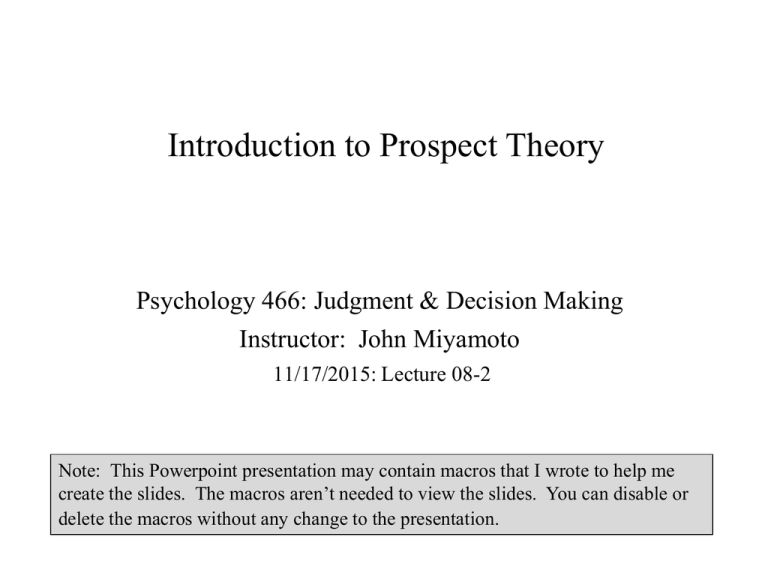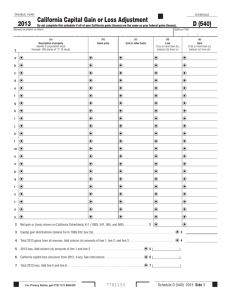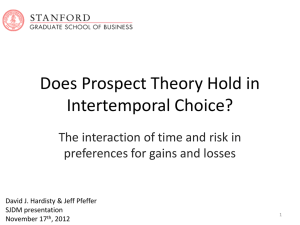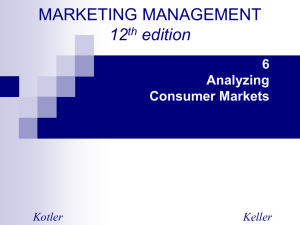lec08-1.p466.a15
advertisement

Introduction to Prospect Theory Psychology 466: Judgment & Decision Making Instructor: John Miyamoto 11/17/2015: Lecture 08-2 Note: This Powerpoint presentation may contain macros that I wrote to help me create the slides. The macros aren’t needed to view the slides. You can disable or delete the macros without any change to the presentation. Outline • Risk attitude & origins of prospect theory • The reflection effect • Framing effects that result from reflection effects • Loss aversion • Framing effects that result from loss aversion ♦ Endowment effect ♦ Chasing sunk costs Psych 466, Miyamoto, Aut '15 Reminder: Concept of Risk Attitude 2 Risk Attitude Risk averse action: A person chooses a sure-thing X over a gamble G where X is less than the expected value of G. ♦ A risk averse person prefers a sure win of $500 over a 50-50 gamble for $1,010 or $0. (Note: Expected value of gamble = $505) Risk seeking action: A person chooses a gamble G over a sure thing X where the expected value of G is less than X. ♦ A risk seeking person prefers a 50-50 gamble for $1000 or $0 over a sure win of $505. (Note: Expected value of gamble = +$500) Psych 466, Miyamoto, Aut '15 Examples of Risk Aversion & Risk Seeking 3 Kahneman & Tversky’s Insights into Risk Attitude • Important Idea #1: People tend to risk averse for gains and risk seeking for losses. • Even More Important Idea #2: These concepts, risk aversion and risk seeking, apply to gains and losses, not to states of wealth. Psych 466, Miyamoto, Aut '15 Table: The Fourfold Pattern of Risk Attitude 4 The Fourfold Pattern of Risk Attitude Small Probabilities Medium to Large Probabilities Gains Risk-Seeking Risk Averse Losses Risk-Averse Risk-Seeking • To understand this table, we need to remember how EU theory explains risk attitude. Psych 466, Miyamoto, Aut '15 Risk Aversion & Utility Curvature 5 • The certainty equivalent (CE) is the surething that is equally desirable as a gamble. Utility Assuming EU Theory, risk aversion is related to the curvature of the utility function Two 90% Truths*: Expected Value • When the utility function is more concave (bulge in curve on upper side), then choices become more risk averse. Utility • When the utility function is more convex (bulge in curve on lower side), then choices become more risk seeking. $ in Thousands Expected Value * "90% Truth" means "unambiguously true if you are an undergrad" and "usually true, but there are exceptions" if you are a grad student. Psych 466, Miyamoto, Aut '15 $ in Thousands Same Analysis with respect to Risk Seeking Utility Function 6 Reflection Effect (More Accurate Version) – the Fourfold Pattern Small Probabilities Medium to Large Probabilities Gains Risk-Seeking Risk Averse Losses Risk-Averse Risk-Seeking • Definition: The reflection effect is the finding that preferences switch from risk averse to risk seeking if we change the outcomes from gains or losses. ♦ The direction of the change, from risk averse to risk seeking or from risk seeking to risk averse, depends on the size of the probabilities. Psych 466, Miyamoto, Aut '15 Ask the Class for Examples in Each Cell of this Table 7 Reflection Effect (More Accurate Version) – the Fourfold Pattern Small Probabilities Medium to Large Probabilities Gains Examples? Examples? Losses Examples? Examples? • Definition: The reflection effect is the finding that preferences switch from risk averse to risk seeking if we change the outcomes from gains or losses. Psych 466, Miyamoto, Aut '15 Show Class Your Examples in Each Cell of This Table 8 Reflection Effect (More Accurate Version) – the Fourfold Pattern • Definition: The reflection effect is the finding that preferences switch from risk averse to risk seeking if we change the outcomes from gains or losses. Psych 466, Miyamoto, Aut '15 Same Slide w-o the Emphasis Rectangles 9 Reflection Effect (More Accurate Version) – the Fourfold Pattern • Definition: The reflection effect is the finding that preferences switch from risk averse to risk seeking if we change the outcomes from gains or losses. Psych 466, Miyamoto, Aut '15 Graphs: Prospect Theory Value Function & Prob Weighting Function 10 Reflection Effect – The Fourfold Pattern of Risk Attitude Small Probabilities Medium to Large Probabilities Gains Risk-Seeking Risk Averse Losses Risk-Averse Risk-Seeking Value Function in Prospect Theory 0.6 0.4 Probability Weight Gains 0.0 0.2 Losses 0.8 Value 1.0 Probability Weighting Function in 1979 Prospect Theory 0.0 Psych 466, Miyamoto, Aut '15 Same Slide w-o Emphasis Rectangles 0.2 0.4 0.6 Stated Probability 0.8 1.0 11 Reflection Effect – The Fourfold Pattern of Risk Attitude Small Probabilities Medium to Large Probabilities Gains Risk-Seeking Risk Averse Losses Risk-Averse Risk-Seeking Value Function in Prospect Theory 0.6 0.4 Probability Weight Gains 0.0 0.2 Losses 0.8 Value 1.0 Probability Weighting Function in 1979 Prospect Theory 0.0 Psych 466, Miyamoto, Aut '15 Transition: Next We Will Focus on Column 3 0.2 0.4 0.6 Stated Probability 0.8 1.0 12 Reflection Effect (More Accurate Version) – the Fourfold Pattern Small Probabilities Medium to Large Probabilities Gains Risk-Seeking Risk Averse Losses Risk-Averse Risk-Seeking Next: Focus of examples will be here. • Definition: The reflection effect is the finding that preferences switch from risk averse to risk seeking if we change the outcomes from gains or losses. Psych 466, Miyamoto, Aut '15 Asian Disease Problem - Gain Frame 13 Asian Disease Problem (Gain Frame) • Problem 1: Imagine that the US is preparing for the outbreak of an unusual Asian disease, which is expected to kill 600 people. Two alternative programs to combat the disease have been proposed. Assume that the exact scientific estimates of the consequences of the programs are as follows: • If Program A is adopted, 200 people will be saved. • If Program B is adopted, there is 1/3 probability that 600 people will be saved, and 2/3 probability that no people will be saved. • Which of the two programs would you favor? Psych 466, Miyamoto, Aut '15 Asian Disease Problem – Loss Frame 14 Asian Disease Problem (Loss Frame) • Problem 2: Imagine that the US is preparing for the outbreak of an unusual Asian disease, which is expected to kill 600 people. Two alternative programs to combat the disease have been proposed. Assume that the exact scientific estimates of the consequences of the programs are as follows: • If Program C is adopted 400 people will die. • If Program D is adopted there is 1/3 probability that nobody will die, and 2/3 probability that 600 people will die. • Which of the two programs would you favor? Psych 466, Miyamoto, Aut '15 Results for Asian Disease Problem 15 Results of Outcome Framing & Reflection Effect Asian Disease Problem: Imagine that the US is preparing for the outbreak of an unusual Asian disease, which is expected to kill 600 people. Two alternative programs to combat the disease have been proposed. Gain Frame (N = 152) Loss Frame (N = 155) If Program A is adopted, 200 people will be saved. 72% If Program C is adopted 400 people will die. 22% If Program B is adopted, there is 1/3 probability that 600 people will be saved, and 2/3 probability that no people will be saved. 28% If Program D is adopted there is 1/3 probability that nobody will die, and 2/3 probability that 600 people will die. 78% Which of the two programs would you favor? Psych 466, Miyamoto, Aut '15 Which of the two programs would you favor? Relation Btwn Asian Disease Problem & Shape of Value Function 16 Asian Disease Problem - Conclusion • Changing the description of outcomes from an emphasis on gains to an emphasis on losses changes the preferences from risk averse to risk seeking. Value Value Function in Prospect Theory Losses Gains • Asian disease problem is an example of a framing effect. • This kind of framing is called “outcome framing” because outcomes are described either as potential gains or potential losses. Psych 466, Miyamoto, Aut '15 Definition of Framing Effects 17 Framing Effects By definition, a framing effect is a change in preference that occurs when: a) the description of the problem is changed, and ... b) the content of the problem is not changed (same outcomes and same probabilities in the two problems). By “content” I mean the logical structure of the problem. If two problems are logically equivalent, they have the same content. • EU theory assumes that framing effects will not occur. ♦ Problem descriptions should not matter if the content stays the same. ♦ EU theory defines the calculation of expected utility in terms of the actual gambles and outcomes, not in terms of a particular manner of presenting the gambles and outcomes. Psych 466, Miyamoto, Aut '15 Why Gain/Loss Framing Changes Preferences 18 Framing Effects Due To Reflection & Gain/Loss Framing Prospect theory (PT) predicts that framing effects can occur when we change the problem description from gains to losses (without changing the objective problem) because ... 1) … people are risk averse for gains and risk seeking for losses; and ... 2) … people are sensitive to changes in value with respect to a reference level (usually the status quo) rather than the objective outcomes. • EU theory denies (2). Many EU theorists would also deny (1). Psych 466, Miyamoto, Aut '15 Adjustment of Status Quo in Prospect Theory 19 Adjustment of Reference Level – Redefinition of Gains & Losses • Do you start becoming risk averse for small losses? Value Function in Prospect Theory Value • What happens when you get richer? E.g., you finish school and get a job? Losses • Example: Hopefully, 5 years from now you will be substantially richer. Will your risk attitude be determined by a shift to the right along the X-axis of the graph? Gains New Wealth • Adaptation Level Theory • Example – Adaptation to ambient lighting in a room. • Example – Adaptation to current level of wealth. Redefinition of gains and losses. Psych 466, Miyamoto, Aut '15 Gain/Loss Framing & Pref Btwn Gambles 20 Framing Effect in Gambles for Apparent Gains or Losses Assume yourself richer by $300 than you are today. Now choose between (a) and (b): (a) A sure gain of $100. 72% prefer (a) in K&T experiment (b) A 50% chance to gain $200 and a 50% chance to gain nothing. Assume yourself richer by $500 than you are today. Now choose between (a') and (b'): (a') A sure loss of $100. (b') A 50% chance to lose nothing and a 50% chance to lose $200. Psych 466, Miyamoto, Aut '15 36% prefer (b’) in K&T experiment EU Analysis of This Problem 21 Expected Utility (EU) Analysis of the Preceding Choice Assume yourself richer by $300 than you are today. Choose between (a) and (b): (a) A sure gain of $100. U(a) = U(current wealth + 300 + 100) = U(current wealth + 400) (b) A 50% chance to gain $200 and a 50% chance to gain nothing. U(b) = (1/2)U(current wealth + 300 + 200) + (1/2)U(current wealth + 300 + 0) = (1/2)U(current wealth + 500) + (1/2)U(current wealth + 300) Assume yourself richer by $500 than you are today. Choose between (a') and (b'): (a') A sure loss of $100. U(a') = U(current wealth + 500 – 100) = U(current wealth + 400) (b') A 50% chance to lose nothing and a 50% chance to lose $200. U(b') = (1/2)U(current wealth + 500 – 0) + (1/2)U(current wealth + 500 – 200) = (1/2)U(current wealth + 500) + (1/2)U(current wealth + 300) NOTE: (a) is equivalent to (a') and (b) is equivalent to (b'). So EU says you should choose (a) and (a’) or (b) and (b’). Psych 466, Miyamoto, Aut '15 Interpretation of This Result 22 Expected Utility (EU) Analysis of the Preceding Choice Assume yourself richer by $300 than you are today. Choose between (a) and (b): (a) A sure gain of $100. U(a) = U(current wealth + 300 + 100) = U(current wealth + 400) (b) A 50% chance to gain $200 and a 50% chance to gain nothing. U(b) = (1/2)U(current wealth + 300 + 200) + (1/2)U(current wealth + 300 + 0) = (1/2)U(current wealth + 500) + (1/2)U(current wealth + 300) Assume yourself richer by $500 than you are today. Choose between (a') and (b'): (a') A sure loss of $100. U(a') = U(current wealth + 500 – 100) = U(current wealth + 400) (b') A 50% chance to lose nothing and a 50% chance to lose $200. U(b') = (1/2)U(current wealth + 500 – 0) + (1/2)U(current wealth + 500 – 200) = (1/2)U(current wealth + 500) + (1/2)U(current wealth + 300) NOTE: (a) is equivalent to (a') and (b) is equivalent to (b'). So EU says you should choose (a) and (a’) or (b) and (b’). Psych 466, Miyamoto, Aut '15 Interpretation of This Result 23 What Does the Preceding Example Show? • Changing the initial wealth level from +$300 to +$500 changes the gamble outcomes from gains to apparent losses. • We can rapidly adjust our reference level, so that what used to be gains are now losses. • We tend to be risk averse for gambles whose outcomes look like gains, and risk seeking for gambles whose outcomes look like losses. Psych 466, Miyamoto, Aut '15 Graphical Comparison of EU Theory vs Prospect Theory 24 EU Utility Function versus Prospect Th Value Function Example 1 Value Function in Prospect Theory Utility Value Utility Function for EU Theory Typical Risk Averse Utility Function Losses Gains Money ($) Example 2 Utility Utility Function for EU Theory Another Somewhat Strange Utility Function Money ($) Psych 466, Miyamoto, Aut'12 • EU theory – utility function does not identify the current (status quo) position. • Prospect theory – status quo determines shift in shape of value function. Mental Accounting 25 Mental Accounting • Mental accounting occurs when we allocate expenses to particular "mental accounts" without looking at the overall balance sheet of expenses. • Mental accounting can produce framing effects, i.e., different descriptions of expenses produce different choices even though the real options are the remain the same. • See next slide for an example. Psych 466, Miyamoto, Aut '15 Jacket & Calculator Purchase 26 Mental Accounting Example • Tversky & Kahneman 1981: Imagine that you are about to purchase a jacket for $125, and a calculator for $15. Situation 1: The salesman informs you that the calculator is on sale for $10 at the other branch of the store, located 20 minutes drive away. Would you make the trip to the other store? Situation 2: The salesman informs you that the jacket is on sale for $120 at the other branch of the store, located 20 minutes drive away. Would you make the trip to the other store? The real choice in either situation is: Option A: Spend $140, save 20 minutes of time. Option B: Spend $135, use 20 minutes to drive to other store. Psych 466, Miyamoto, Aut '15 Results for this experiment 27 Results for the Mental Accounting Example The real choice is Option A: Spend $140, save 20 minutes of time. Option B: Spend $135, use 20 minutes to drive to other store. With either option, you end up owning a jacket and a calculator. -------------------------------------------------------------------------------------------------------- • Situation 1: 68% of subjects choose Option A. ♦ Attracted to the reduction of the $15 expense to $10 for calculator. • Situation 2: 29% of subjects choose Option A. ♦ Not attracted to the reduction of the $125 expense to $120 for jacket. • People are more interested in saving $5 out of $15 dollar expense than saving $5 out of $125 dollar expense. People don't look at the bottom line. • Framing effect! Psych 466, Miyamoto, Aut '15 Theater Ticket Example 28 Theater Example (Mental Accounting) – Lose $10 • Problem 8 [N = 183]: Imagine that you have decided to see a play where admission is $10 per ticket. As you enter the theater you discover that you have lost a $10 bill. Would you still pay $10 for a ticket for the play? • Yes [88 per cent] • No [12 per cent] Psych 466, Miyamoto, Aut '15 How do you analyze this problem? Comparison Btwn EU & PT 29 Theater Example (Mental Accounting) – Lose Ticket • Problem 9 [N = 200]: Imagine that you have decided to see a play and paid the admission price of $10 per ticket. As you enter the theater you discover that you have lost the ticket. The ticket was for open seating and it cannot be recovered. Would you pay $10 for another ticket? • Yes [46 per cent] • No [54 per cent] Psych 466, Miyamoto, Aut '15 How do you analyze this problem? Summary of Theater Ticket Example 30 Theater Example - Summary Regardless of whether you lose $10 cash or you lose the ticke, your real choices are: • Bottom Line for Option 1: Go home without seeing the play. You are $10 poorer. • Bottom Line for Option 2: Get a theater ticket. You see the play. Your are $20 poorer. • People choose Option 1 if they lose the ticket but they choose Option 2 if they lose the money for the ticket. • Example of mental accounting. Violation of EU theory. Psych 466, Miyamoto, Aut '15 Conclusions re Mental Accounting 31 Conclusions re Mental Accounting • EU theory says that we should make choices based on how they affect our total personal assets - not how these assets are described or labeled as gains and losses. • Psychologists find that people keep track of utility relative to separate "mental accounts." ♦ Purchasing example ♦ Lost theater ticket versus lost money for a theater ticket • Framing effects due to mental accounting: People sometimes switch preferences when: (a) we keep the bottom line constant, but (b) we change the way that gains and losses are assigned to particular mental accounts. Psych 466, Miyamoto, Aut '15 32 Conclusion: Framing effects are important! Prospect theory ♦ The value function is concave for gains and convex for losses. This tends to make people risk averse for gains and risk seeking for losses. ♦ People are sensitive to changes in wealth (gains and losses). • The Asian disease problem and gamble framing effects show that people’s preferences change depending on the way a problem is described. • Mental accounting shows that we calculate gains and losses with respect to "mental accounts" (not a total accounting of our state of wealth). • Labeling as gains or losses influences decisions even when the bottom line stays the same. Psych 466, Miyamoto, Aut '15 Comment: Manipulating Political Frames to Motivate People to Take Action 33 Example: Motivating People Towards Political Action • Getting people to take action – emphasize potential losses due to inaction. • Example: Lobbying for the Equal Rights Amendment (ERA). • Example: American Christian conservatives emphasize the Christian faith of founding Americans (circa the American Revolution). • Christians have "lost" their rights to practice their faith in modern secular America. • "Take back America!" • Example: Politics of victimization - if you are a victim, you must take action to regain what has been taken from you. Psych 466, Miyamoto, Aut '15 Summary – How EU & Prospect Theory Differ 34 Probability Weighting Function in 1979 Prospect Theory 0.6 0.4 Probability Weight How Prospect Theory (PT) Differs From Expected Utility (EU) Theory 0.2 Gains 0.0 Losses 0.8 Value 1.0 Value Function in Prospect Theory 0.0 0.2 0.4 0.6 0.8 1.0 Stated Probability Expected Utility Theory Prospect Theory The basic objects of preference are states of wealth (including non-monetary resources like health). The basic objects of preference are changes from a neutral reference point (gains and losses). The utility function is risk averse everywhere. (Most theorists) The value function is risk averse for gains, risk seeking for losses. Loss aversion cannot be defined (EU theory does not identify a status quo.) The value function implies loss aversion. People evaluate probabilities linearly. People evaluate probabilities nonlinearly. Problem description should have no effect as long as the problem is logically the same. Problem description can change the reference level; hence the definition of gains & losses can change. All outcomes are evaluated with respect to People evaluate gains and losses with one big account. respect to mental accounts. Psych 466, Miyamoto, Aut '15 Next: Focus on Loss Aversion 35 1.0 0.8 0.6 0.4 Gains 0.0 0.2 Losses How Prospect Theory (PT) Differs From Expected Utility (EU) Theory Probability Weighting Function in 1979 Prospect Theory Probability Weight Value Value Function in Prospect Theory 0.0 0.2 0.4 0.6 0.8 1.0 Stated Probability Expected Utility Theory Prospect Theory The basic objects of preference are states of wealth (including non-monetary resources like health). The basic objects of preference are changes from a neutral reference point (gains and losses). The utility function is risk averse everywhere. (Most theorists) The value function is risk averse for gains, risk seeking for losses. Loss aversion cannot be defined (EU theory does not identify a status quo.) The value function implies loss aversion. People evaluate probabilities linearly. People evaluate probabilities nonlinearly. Problem description should have no effect as long as the problem is logically the same. Problem description can change the reference level; hence the definition of gains & losses can change. All outcomes are evaluated with respect to People evaluate gains and losses with one big account. respect to mental accounts. Psych 466, Miyamoto, Aut '15 Graph Showing Loss Aversion 36 Loss Aversion ♦ Example: Compare the pleasure of unexpectedly finding $100 to the pain of unexpectedly losing $100. Psych 466, Miyamoto, Aut '15 Loss Aversion: A loss has greater impact than an objectively equal gain. Value • Loss aversion – the pain of losing X is greater than the pleasure of gaining X. -x Losses +x Gains Credit Cards: Cash Discount versus Credit Card Surcharge 37 Gasoline Price: Cash Discount or Credit Card Surcharge During 1979 oil crisis, the oil companies wanted to charge a fee for using a credit card to buy gasoline. E.g., gas would cost 94¢ per gallon with cash payment or 97¢ per gallon with a credit card payment. The federal government got involved in the issue of how the pricing should be labeled. • Labeling Solution 1: The gas price should be labeled 94¢/gallon for cash with a 3¢/gallon credit card surcharge. • Labeling Solution 2: The gas price should be labeled 97¢/gallon on a credit card with a 3¢/gallon cash discount. ♦ Value Question: Assuming that the oil companies wanted to encourage the use of credit cards, which solution will cause more consumers to use credit cards? Why? Loss Aversion: A loss has greater impact than an objectively equal gain. -x Losses Diagram x Gains This is a practical example of how a framing can influence consumer behavior. Psych 466, Miyamoto, Aut '15 Wine Owner Example 38 The Wine Example (for Endowment Effect) KK&T: Kahneman, D., Knetsch, J. L., & Thaler, R. H. (1991). The endowment effect, loss aversion, and status quo bias. Journal of Economic Perspectives, 5, 193-206. • A wine-lover bought wine for $10/bottle, but now it is worth $200/bottle at auction. • This wine-lover is not willing to pay $200/bottle for more bottles of this wine. • This wine-lover would not sell any of his wine for $200/bottle. • Is this behavior odd? Psych 466, Miyamoto, Aut '15 Endowment Effect & Loss Aversion 39






